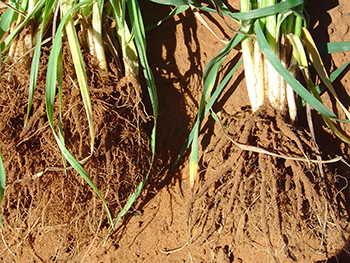Plant-strengthening agent a result of joint effort between UFS and German company

Research over the past few years has showed that the agent applied mostly as a foliar spray subsequently leads to better seedlings as well as growth and yield enhancement of various crops. |
The application of a plant-strengthening agent in the agricultural industry has, until recently, been largely ignored, says Dr Elmarie van der Watt of the Department of Soil, Crop, and Climate Sciences at the University of the Free State (UFS). The agent was co-developed by researchers at the UFS and a German company.
The product is moving into new markets, such as China, Vietnam, the USA, and Australia.
ComCat® was the result of extensive research by the German company Agraforum AG. Commercialisation was limited initially to Europe, while research was expanded to other parts of the world, with the University of the Free State as the main research centre. ComCat® is a unique, non-toxic plant strengthening agent derived from wild plants. It enhances plant growth and yield, as well as resistance against abiotic and biotic stress factors.
Dr Van der Watt says that, in nature, plants communicate and interact by means of allelochemicals (the inherent silent tool of self-protection among plants) and other phytochemicals (chemical compounds that occur naturally in plants), as part of their resistance mechanisms towards biotic and abiotic stress conditions.
Most wild-plant varieties are usually well-adapted to resist these stress factors. However, monoculture crops have lost this ability to a large extent. “Active compounds contained in extracts from wild plants applied to monoculture crops can potentially supply the signal for the latter to activate their dormant resistance mechanisms.”
Research over the past few years has showed that the agent applied mostly as a foliar spray subsequently leads to better seedlings as well as growth and yield enhancement of various crops. A major advantage is that, despite its enhancing effects on root development and yield, it does not induce unwanted early vegetative growth that could jeopardise the final yield, as happened in the past for nitrogen application at an early growth stage.
Dr Van der Watt says, “Physiological data on the effect of the natural bio-stimulant product on photosynthesis, respiration, and resistance towards biotic stress conditions indicate that it can be regarded as a useful tool to manipulate agricultural crops. Research also showed that the field of application for this natural product is never-ending, and new applications are being investigated every day.”